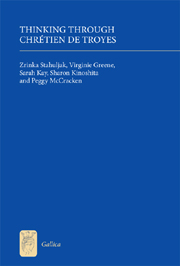Book contents
- Frontmatter
- Contents
- Preface
- Introduction
- 1 The “Changeful Pen”: Paradox, Logical Time, and Poetic Spectrality in the Poems Attributed to Chrétien de Troyes
- 2 Imagination
- 3 Adventures in Wonderland: Between Experience and Knowledge
- 4 Feudal Agency and Female Subjectivity
- 5 Forgetting to Conclude
- Epilogue
- Appendix I Sigla of the Principal Manuscripts of the Chrétien Romances
- Appendix II Lyric Texts, Textual Notes and Translations
- Appendix III Passages from Cligés for Comparison with Lyric Texts
- Appendix IV Variants to the “Cart Scene” in Le Chevalier de la Charrete
- Bibliography
- Index
- Title in the Series
1 - The “Changeful Pen”: Paradox, Logical Time, and Poetic Spectrality in the Poems Attributed to Chrétien de Troyes
Published online by Cambridge University Press: 05 February 2013
- Frontmatter
- Contents
- Preface
- Introduction
- 1 The “Changeful Pen”: Paradox, Logical Time, and Poetic Spectrality in the Poems Attributed to Chrétien de Troyes
- 2 Imagination
- 3 Adventures in Wonderland: Between Experience and Knowledge
- 4 Feudal Agency and Female Subjectivity
- 5 Forgetting to Conclude
- Epilogue
- Appendix I Sigla of the Principal Manuscripts of the Chrétien Romances
- Appendix II Lyric Texts, Textual Notes and Translations
- Appendix III Passages from Cligés for Comparison with Lyric Texts
- Appendix IV Variants to the “Cart Scene” in Le Chevalier de la Charrete
- Bibliography
- Index
- Title in the Series
Summary
The attributions to Chrétien de Troyes of the lyrics “Amors tençon et bataille” (R.-S. 121) and “D'Amors qui m'a tolu a moi” (R.-S. 1664) have not been contested since they were confirmed as belonging to the Chrétien corpus by Förster in 1914. Although Zai's 1974 edition prints the texts of three other grands chants courtois ascribed to Chrétien by one or more manuscript(s), no one now accepts these attributions, and the only one which, in the past, was ever admitted into the Chrétien canon is “De joli cuer chanterai” (R.-S. 66). However, the two canonical lyrics, although ascribed to Chrétien in some chansonniers, are anonymous or assigned to different trouvères in others. This chapter does not set out to revive long-dead arguments over attribution; but it is important to stress that the medieval evidence for Chrétien as lyric poet is divided and inconsistent, just as the survival of the texts themselves is precarious. The contention of our Introduction, that the “maître champenois” is better seen as an enabling fiction of literary history than as an attested historical reality, is especially clear in the case of “his” lyrics, which offer vivid confirmation of the inevitable mutability or variance of medieval texts and its widely accepted consequence that medieval textuality is an unresolved plurality: “Mais y a-t-il une voix des textes au Moyen Age, ne faut-il pas toujours, dans la pratique, pluraliser l'origine?”
- Type
- Chapter
- Information
- Thinking Through Chrétien de Troyes , pp. 15 - 40Publisher: Boydell & BrewerPrint publication year: 2011

